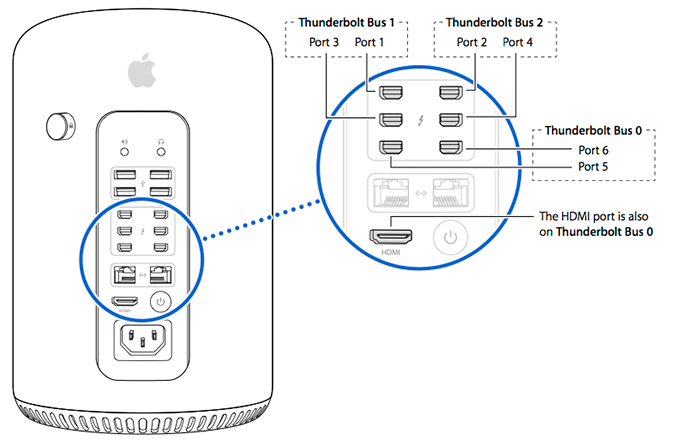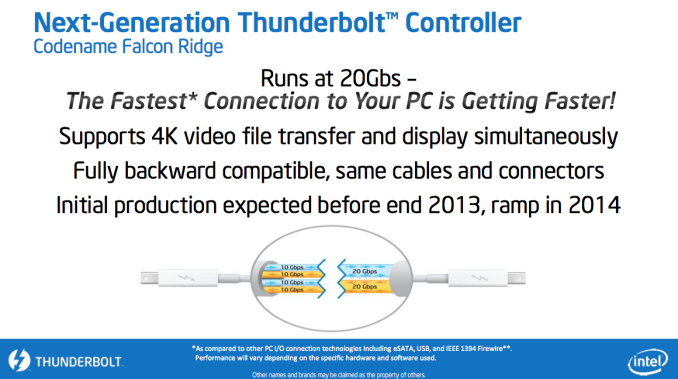The Mac Pro Review (Late 2013)
by Anand Lal Shimpi on December 31, 2013 3:18 PM ESTThunderbolt 2
The new Mac Pro integrates three Intel Falcon Ridge Thunderbolt 2 controllers. These are the fully configured controllers, each supporting and driving two Thunderbolt 2 connectors on the back of the Pro for a total of 6 ports.
Pairing Thunderbolt 2 with Ivy Bridge EP is a bit tricky as Apple uses Thunderbolt 2 for display output as well as data. Typically you’d route all display through processor graphics, but in the case of IVB-EP there is no integrated graphics core. On a DIY PC you enable display output over Thunderbolt 2 by running an extra cable out of the discrete GPU and into a separate input that muxes the signal with PCIe and ships it out via another port as Thunderbolt. Here’s where Apple’s custom PCB work comes in handy as all of this is done internal to the Mac Pro. The FirePro’s display outputs are available via any two of the six Thunderbolt 2 ports, as well as the lone HDMI port on the back of the Mac Pro.
How does Thunderbolt 2 differ from the original? For starters, it really would’ve been more accurate to call it Thunderbolt 4K. The interface is fully backwards compatible with Thunderbolt 1.0. You can use all previous Thunderbolt peripherals with the Mac Pro. What’s new in TB2 is its support for channel bonding. The original Thunderbolt spec called for 4 independent 10Gbps channels (2 send/2 receive). That meant no individual device could get access to more than 10Gbps of bandwidth, which isn’t enough to send 4K video.
Thunderbolt 2 bonds these channels together to enable 20Gbps in each direction. The total bi-directional bandwidth remains at 40Gbps, but a single device can now use the full 20Gbps. Storage performance should go up if you have enough drives/SSDs to saturate the interface, but more importantly you can now send 4K video over Thunderbolt. Given how big of a focus 4K support is for Apple this round, Thunderbolt 2 mates up nicely with the new Mac Pro.
So far I’ve been able to sustain 1.38GB/s of transfers (11Gbps) over Thunderbolt 2 on the Mac Pro. Due to overhead and PCIe 2.0 limits (16Gbps) you won’t be able to get much closer to the peak rates of Thunderbolt 2.

The impact of chaining a 4K display on Thunderbolt 2 downstream bandwidth
Here’s where the six Thunderbolt 2 and three TB2 controllers come into play. Although you can daisy chain a 4K display onto the back of a Thunderbolt 2 storage device, doing so will severely impact available write bandwidth to that device. Remember that there’s only 20Gbps available in each direction, and running a 3840 x 2160 24bpp display at 60Hz already uses over 14Gbps of bandwidth just for display. I measured less than 4Gbps of bandwidth (~480MB/s) available for writes to a Thunderbolt 2 device downstream from the Mac Pro if it had a 4K display plugged in to it. Read performance remained untouched since display data only flows from host to display, leaving a full 20Gbps available for reads. If you’re going to connect Thunderbolt 2 devices to the Mac Pro as well as a 4K display, you’ll want to make sure that they aren’t on the same chain.
If we start numbering in the top left corner of the 2 x 3 array of Thunderbolt ports and go left to right down the stack, you'll want to first populate ports 1, 2 and 5 before filling in the rest. The diagram below should help simplify:












267 Comments
View All Comments
Dandu - Friday, January 10, 2014 - link
Hi,It's possible to use a 2 560 x 1 440 HiDPI definition, with a NVIDIA card, a 4K Display and the (next) version of SwitchResX.
I have tested that : http://www.journaldulapin.com/2014/01/10/ultra-144...
Haravikk - Sunday, January 12, 2014 - link
The news about the USB3 ports is a bit strange, doesn't that mean a maximum throughput of 4gbps? I know most USB3 storage devices will struggle to push past 500mb/sec, but that seems pretty badly constrained. Granted, Thunderbolt is the interface that any storage *should* be using, but the choices are still pretty poor for the prices you're paying, and no-one offers Thunderbolt to USB3 cables (only insanely priced hubs with external power).Otherwise the review is great, though it'd be nice to see more on the actual capabilities of Apple's FirePro cards. Specifically, how many of the FirePro specific features do they have such as 30-bit colour output, EDC, ECC cache memory, order-independent-transparency (under OpenGL) and so-on? I'm assuming they do given that they're using the FirePro name, but we really need someone to cover it in-depth to finally put to rest claims that consumer cards would be better ;)
eodeot - Monday, February 24, 2014 - link
I'd love a realistic comparison with an i7 4770k and say, 780ti.You also compare 12 cored version to older 12 core versions that hide behind (fairly) anonymous xeon labeling that hide their chip age (sandy/ ivy bridge/haswell...). I'd like to see in how any real world applications does a 12 core chip perform faster. Excluding 3d work and select video rendering, I doubt there is much need to extra cores. You note how its nice to have buffer of free cores for everyday use, while heavy rendering- but I never noticed a single hiccup or a slowdown with 3d rendering on my i7 4770k with all 8 logical cores taxed to their max. How much of better performance then "butter smooth" one already provided with a much cheaper CPU can you get?
Also you compare non apple computers with same ridiculous CPU/GPU combinations. Who in their right mind would choose a 4core Xeon chip over a haswell i7? The same goes for silly "workstation" GPU over say a Titan. Excluding dated opengl 3d apps, no true modern workstation benefits from a "workstation" GPU, if we exclude select CUDA based 3d renderers like iray and vray rt that can benefit from 12gb of ram. GPUs included with Apple Mac pro have 2gb... Not a single valid reason a sane person would buy such a card. Not one.
Also, you point out how gaming makes the most sense on windows, but do no such recommendation for 3d work. Like games, 3d programs perform significantly better under directX and that leaves windows as a sole option for any serious 3d work...
I found this review interesting for design Apple took, but everything else appears one sided praise...
pls.edu.yourself - Wednesday, February 26, 2014 - link
QUOTE: "The shared heatsink makes a lot of sense once you consider how Apple handles dividing compute/display workloads among all three processors (more on this later)."Can anyone help point me to this. I think one of my GPU's is not being used.
PiMatrix - Saturday, March 8, 2014 - link
Apple Fixed the HiDPI issue on Sharp K321 in OS 10.9.3. Works great. Supported HiDPI resolutions are the native 3840x2160, and HiDPI: 3200x1800, 2560x1440, 1920x1080, and 1280x720. You can also define more resolutions with QuickResX but the above seem to be enough. Using 3200 x1800 looks fantastic on this 4K display. Great job Apple!le_jean - Monday, March 10, 2014 - link
Any information on updated 60Hz compatibility concerning Dell's UP 2414Q in 10.9.3?I would be very interested to get some feedback in relation to:
nMP & Dell UP 2414Q
rMBP & Dell UP 2414Q
I remember in anandtech review of late 2013 nMP there have been issues concerning that specific display, while Sharp and ASUS performed just fine
philipus - Monday, April 14, 2014 - link
As a happy photo amateur, I have to say the previous Mac Pro is good enough for me. I have the early 2008 version which I like because of its expandability. Over the years I have added drives, RAM and most recently a Sonnet Tempo Pro with two Intel 520 in order to get a faster system. As cool and powerful as the new Mac Pro is, it would cost me quite a lot to add Thunderbolt boxes for the drives I currently use, so it is not worth it for me.I do agree that it is about time a manufacturer of desktop computers pushed the platform envelope. It's been tediously samey for a very long time. I'm not surprised it was Apple that made the move - it's in Apple's DNA to be unexpected design-wise. But as much as it is nice to see a radical re-design of the concept of the desktop computer, I think a future version of the Mac Pro needs to be a bit more flexible and allow more user-based changes to the hardware. Even if I could afford the new Mac Pro - and I would also place it on my desktop because it's really pretty - I wouldn't want to have several Thunderbolt boxes milling around with cables variously criss-crossing and dangling from my desk.
walter555999 - Saturday, June 7, 2014 - link
Dear Anand, could you post how to connect a up2414Q to macbook pro retina (2013) ? I have tried a cable mini display port-HDMI. But there are no image in the dell monitor. Thank you very much. WalterFasarinen - Saturday, August 9, 2014 - link
Thanks for an excellent review. (And hello, everybody; this is my first post on this site.)I noticed, in the "GPU choices" section, what seems to be a very useful utility for monitoring the GPU. The title on the top of the screen is "OpenCL Driver Monitor"; the individual windows (which are displaying graphs of GPU utilisation) seem to be titled "AMDRadeonXL4000OpenCLDriver".
I'm probably just being dim, but a bit of googling doesn't shed much light. If anybody could point to me to where this utility can be obtained from, I'd be most grateful.
Thanks ....
pen-helm - Friday, September 12, 2014 - link
I showed this page to a Mac user. They replied:I'm pretty sure that this simple fix takes care of the issue with
monitors where OS X doesn't offer a HiDPI mode:
http://cocoamanifest.net/articles/2013/01/turn-on-...